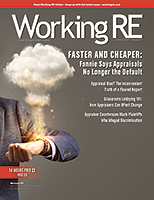 |
> PCV Murcor
> OREP E&O |
Risks and Benefits of Hybrid and Desktop Appraisals
by Jo A. Traut, McKissock Learning
When appraisers receive appraisal assignment requests, they ask themselves if the fee is acceptable, am I competent for this assignment, can I meet the deadline, and so on. With the GSE appraisal modernization program, appraisers will more likely be asked to complete desktop or hybrid appraisal assignments in the future.
You are unlikely to see an immediate surge in desktop and hybrid appraisal assignments in the current volatile real estate market, but once normalcy returns to the mortgage rates and the housing market (as it always does), you can expect them to increase. We have been here before; appraisers faced the same issues with the initial acceptance of exterior-only (drive-by) appraisals in the 1990s by the GSEs.
At first glance, desktop and hybrid appraisals may seem like driving a car on an icy road. All of us tend to be extra cautious, as we should. This was the same process many of us underwent with the exterior-only (drive-by) inspections. If the appraiser does not see the interior of the dwelling, how could the appraisal be credible? Over time, we became accustomed to these assignments and agreed to perform them when we felt that a limited scope of work (an exterior inspection only) could still produce a credible appraisal. For the property’s interior physical characteristics, we relied on other sources.
Individual real estate appraisers may decide not to perform desktop and hybrid appraisal assignments due to the fee, the fact that they enjoy performing property inspections, or the fact that they are uncomfortable depending on others that they did not directly engage. Each of these reasons is valid, and you need to make your own business decision.
For others, desktop and hybrid appraisals may be a viable and even advantageous product to add to their appraisal practice. Analyzing, researching, and developing an appraisal may be preferable over performing a personal inspection. You may be interested in semi-retirement or have mobility concerns, so these products are a perfect fit. Alternatively, you may enjoy adding these products into your existing appraisal assignment mix.
It is possible to complete a desktop or hybrid appraisal without having any greater risk (possibly even less risk) than when you complete a traditional appraisal. Your inspection did not take place on-site, so it would be more difficult for someone to claim that you missed a structural crack in the basement’s foundation, that you rendered an appraisal with bias because of the homeowner’s race, gender, or another protected class, or that you were unprofessional and rude during the inspection (after all, you never met the homeowner/borrower, or agent).
Even so, it is your responsibility to ensure that the scope of work (level of inspection) does not adversely impact the credibility of the appraisal. Additional items to consider before agreeing to perform an assignment, during the appraisal development process, and disclosures to minimize your risk are listed below.
Before Agreeing to Perform the Assignment:
• Identify any restrictions regarding desktop or hybrid appraisals and check for any limitations in your state.
• Assess your competency in completing the specific appraisal assignment.
• Request a reasonable fee based on the time involved in developing, analyzing, and reporting the appraisal. If the inspection and windshield time take 20 percent of the appraisal time, then the analysis, research, and development must take 80 percent. You should charge close to that 80 percent fee for this limited scope appraisal (since you are doing the same level of research, development, and reporting).
• Confirm that you are covered by your appraisal E&O insurance policy for hybrid and desktop appraisals.
• Review the engagement letter to ensure that you understand your responsibility and any third-party inspector’s responsibility.
• Should you have any questions or need clarification about the property condition report or the floorplan, are you permitted to contact the third-party property data collector? It could save you a considerable amount of time.
(story continues below)
(story continues)
While Completing the Desktop or Hybrid Appraisal:
• Verify the information and data included in the property condition report to the level that makes it reasonable for you to believe it is credible. The property condition report and floorplan should be checked against other sources such as MLS, aerial images, and public records.
• Is there adequate photographic evidence (in the PCR or available from alternative sources) to support any opinions in the property inspection report regarding conformity, condition, quality, deficiencies, or positives about the subject property?
• View aerial imagery of the subject property and identify any positive or negative exterior influences. In your appraisal report, note the date of the aerial photo source. As an example, imagine that you are using Google Maps and the aerial photo is date stamped January 13, 2020.
You would note that you have viewed a Google Maps aerial image and the date is January 13, 2020.
Items to Disclose or Report in your Desktop or Hybrid Assignment:
• Check the preprinted language, the limiting conditions, the intended use, and the certification for USPAP compliance.
• Indicate which sources were used to verify the data, when they were used, and to what degree the data were verified.
• Clearly and conspicuously disclose the scope of work, including what was not done as well as what was done.
• Ensure there is enough information in the report for the intended users (and also other readers) to understand the extent of a third-party inspection performed for a hybrid appraisal.Example: The appraiser did not inspect the subject property. A property data collector (engaged by the lender) reported the physical characteristics, condition, and conformity of the property. Factual characteristics of the subject property reported by the property data collector were confirmed by MLS listing information dated March 14, 2021, and by aerial imagery dated January 13, 2020.
• Include a disclaimer stating that the appraiser assumes no responsibility if the appraisal is relied upon by parties other than those identified by the appraiser in the appraisal report as intended users.
• Hybrid appraisals should clearly state that the information regarding the physical characteristics and condition of the property is not a home inspection—that the appraiser is not responsible for the accuracy of such items provided by other parties.Example: The client, intended user, and any party not identified as an intended user understands the assumptions necessary regarding the data collection process and accepts the risks associated with it and agrees that the appraiser has no responsibility for any matter relating to the condition of the property or other matters reported by any third party or data resource.
• In order to mitigate risk, it is important to disclose what work was performed by the appraiser and what work was completed by others. An appraiser should perform work that corresponds to their responsibilities as stated in the engagement letter and certifications, at a minimum.
Like driving on an icy road, you must be aware of potential risks and take steps to reduce them. As you learned how to adapt to the exterior-only inspection appraisal assignments, you can navigate the challenges of hybrid and desktop appraisals by carefully considering your competency, the scope of work (level of inspection and by whom), and clearly reporting your research and sources.
About the Author
Jo Traut has been a real estate appraiser since 1997, and currently holds a certified residential appraiser license in Illinois and Wisconsin. Jo specializes in appraising luxury homes, valuations for lending purposes, relocation appraisals, appraisal review, and appraisal compliance. Jo was Residential Chief Appraiser for the 5th largest Bank in the United States. Jo currently serves as Director of Appraisal Curriculum at McKissock Learning www.mckissock.com.
OREP Insurance Services, LLC. Calif. License #0K99465




by marmarcapp@mail.com
Until when do fannie mae and freddie and the mortgages want to continue stealing the fees from the appraisers? Until when are we going to put up with their inefficiencies?
-by Erich Schacht
Oh my. Your article is so completely an utterly full of holes. I simply don’t have the time to address all of the points. I did chuckle at your suggestion on fee structure. My first appraisal took me about 30 hours to complete. Based on that, I apparently should have charged about $2,000. The reality of it is, I actually should not have charged a fee at all since the appraisal was absolutely terrible. That’s because I didn’t know what I was doing !!! Fast forward 30+ years and I recently completed an appraisal on a home I’ve inspected twice before. Cookie cutter property that, after the inspection, took me about 60 minutes to complete. What to charge, what to charge? According to you, next to nothing based on the time required. The overlooked fact of the matter is appraiser’s get paid for what they know. If I wanted to get paid by the hour, I would have chosen a different profession. Compare the fees charged 30 years ago to today’s fees. Name another profession where the average income has barely doubled in that time frame. And people wonder why nobody wants to get into the appraisal profession.
-by 3rd party observer
These are acceptable, viable and profitable. There shouldn’t be a question. COVID procedures had all of us on the outside only. This is not a jump for me. No doom and gloom over my future. The hybrids require the same research and I make the same fee.
-